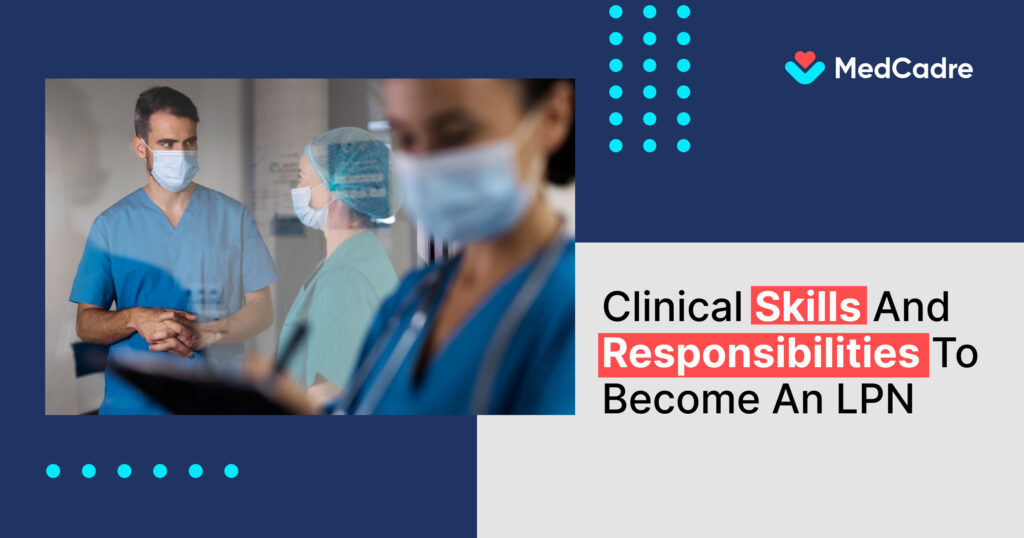The medical field is vast, with many fruitful opportunities and endless benefits. There are many job roles in the medical field, and a licensed practical nurse(LPN) is one of the jobs that offers various advantages. LPNs play a crucial role in the healthcare sector. LPNs are equipped with a combination of practical and theoretical knowledge, hands-on skills, and responsibilities to provide proper patient care.
In this blog, we will understand how to become an LPN and the skills required to excel in this career.
How to become a licensed practical nurse: understanding the LPN training program
Educational requirement
In your quest “how to become an LPN,” you must obtain theoretical knowledge and practical skills. You can complete the LPN training program quickly, and it is comparatively much less than the other registered nurses. The following are the necessary steps to become an LPN:
- High school diploma OR GED: A high school diploma acts as a pillar to pursue your dream LPN career.
- Accredited LPN program: Sign up for a state-approved LPN program. This program is offered at vocational schools, community colleges, or hospitals. This is a one-year program that involves classroom training and clinical labs in healthcare settings.
- Pass the NCLEX-PN exam: In order to be an LPN, one must pass the National Council Licensure Examination for Practical Nurses (NCLEX-PN).
Clinical skills training
Clinical skills are one of the key components of LPN training. This training involves supervised clinical skills rotations, which allow trainee nurses to observe and learn in natural healthcare environments. This practical knowledge assists in providing proper patient care. For better patient care, one must have the desired LPN skills and competencies.
Still wondering, “how to become a LPN”? Here are the clinical skills that encompass a wide range of areas, including:
Patient assessment
The first responsibility of an LPN is assessing the patient’s condition and providing care accordingly. Patient history, current symptoms, vital signs, and any medical history are the assessments involved. LPN assessment contributes to precise diagnosis and effective patient treatment.
Medication administration
LPN duties and responsibilities involve prescribing the proper medication. To ensure proper medication, LPNs should undergo a medical administration program. Patients must follow the prescribed medication safely and effectively; the LPN should follow up on this. LPNs also work closely with the patient to understand the condition.
- Review patient information: One of the key LPN responsibilities is reviewing patient information. LPNs should analyze their past medication and the medication they currently provide.
- Identify the correct medication: Ensuring the patient received the proper medication.
- Administer medication: LPN must check if patients are following the medication course. This involves giving pills orally, administering injections, or using other routes of administration.
- Monitor side effects: Sometimes, the given medication may cause side effects. LPNs should identify the condition and inform the supervisors.
Wound care
Wound care is crucial in LPN training and an important skill for LPNs.The more skilled you are in wound care, the higher your chances of securing a potential job. The primary tasks involved in wound care are identifying the wound condition and dressing, obeying the physician’s instructions, and following up on the medication with patients. If any complications are found, you must inform the registered nurse or doctor.
Intravenous (IV) therapy
LPNs must gain in-depth knowledge of intravenous therapy. One of the primary tasks is to supervise Intravenous therapy, which should be done only under the supervision of an RN. The critical tasks in Intravenous therapy are regular monitoring, looking out for complications, understanding the associated problems, and ensuring the fluids are balanced.
Patient education
LPNs work closely with patients and their families and are responsible for providing clear and concise instructions to the patient’s family members. This involves educating their families on medication and necessary care post-discharge in soft language, avoiding technical jargon. In order to avoid confusion, LPNs should address this in an active voice.
What are the core LPN duties and responsibilities?
It is time to explore the core duties and LPN responsibilities and how an LPN is a critical aspect of overall patient care.
Collaboration with the healthcare team
- The first step for better patient care is for LPNs to collaborate with RNs, physicians, and other healthcare professionals to address patient care. 100% patience is only possible with sustainable teamwork.
Monitoring patient progress
- The duties and responsibilities of a Licensed Practical Nurse (LPN) include regularly monitoring and documenting the progress of patients.This involves tracking vital signs, observing symptom changes, and communicating findings to the healthcare team.
Assisting with activities of daily living (ADLs)
- A patient’s overall condition is directly related to his daily activities. Bathing, dressing, and feeding are essential activities of daily living, and LPNs must ensure patients are following ADLs.
Advocating for patients
-
LPNs should go beyond their role and play as advocates. They address their concerns and needs by bridging the gap between patients and the healthcare team. You can enhance patient care by providing the right advocacy.
Also read: Licensed Practical Nurse Salary Guide 2024: How Much Do LPNs Make?
Ethical considerations and professionalism for LPN duties and responsibilities
LPNs play a vital role in the healthcare department. Any single, tiny mistake can be questionable and affect your professionalism. LPNs must follow the code of ethics and maintain professionalism on the floor. Respecting patients, keeping their information confidential, displaying your work style, and adhering to the principles of beneficence and non-maleficence are necessary steps to maintain professionalism and adhere to the code of ethics.
How to apply for an LPN job after training and certification?
Once the training is completed and you obtain the certification and licenses, you can apply for the desired job. Many aspirants are confused about how to become an LPN, with just basic job requirements getting fulfilled. Here comes MedCadre into the picture.
MedCadre is one of the leading healthcare job providers in the US, with hundreds of job listings from every corner of the country. We associate with top healthcare facilities and address their manpower requirements. With a team of 100+ professional recruiters, we are paving the way for talented job seekers. MedCadre offers flexibility by providing many job options that fit your requirements and skill set.
Following are the simple steps to your dream job.
- Visit the MedCadre website.
- Explore the career page and find jobs that match your qualifications and interests.
- Apply for the positions that match your requirements.
- Soon, you will receive a call from our executive.
Conclusion
Many wonder, “how long does it take to become a LPN?”. The only reliable way is to acquire a foundation in education, get hands-on training to learn the common LPN duties and responsibilities, and display a commitment to ethical and professional standards. LPN is a challenging role that offers many rewards and benefits. Patience and commitment are the key things that will drive you to your dream job.


